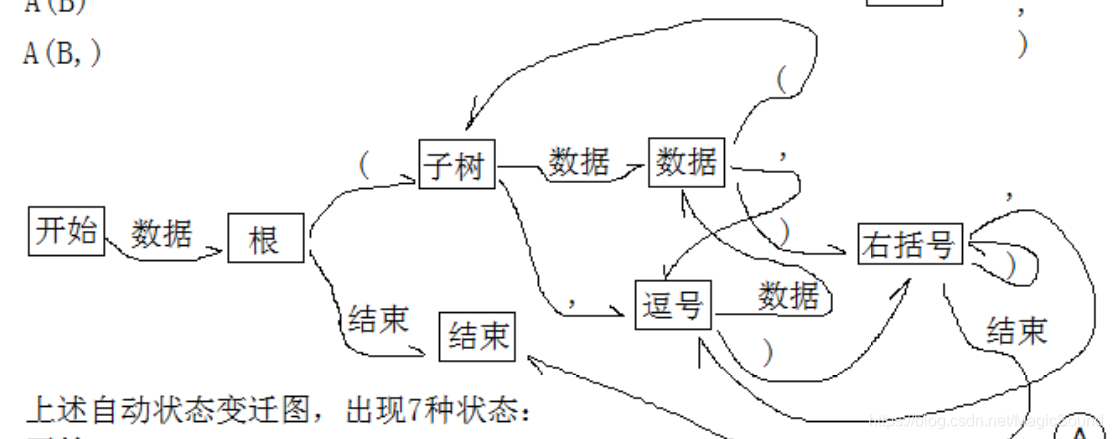此次编程目的是将A(B(D(F,G),J(,L(K))),C(E(H,I)))基于这种二叉树表达形式,根据所给生成二叉树
首先是每个节点的存储类型:
typedef struct B_TREE {
int data;
struct B_TREE *left;
struct B_TREE *right;
}B_TREE;
每个节点由该点数据和其左右孩子
意识到这种操作实际和表达式获取数据是类似的,在遇字符后改为指定状态进行操作,此时可以用上状态变迁图

此时不进行括号失配等特殊问题的考虑,状态变迁图先在理想正确情况下完成基础形式,之后再慢慢完善
状态变迁图完成后,程序的基本框架就可以写出来了
共有开始,跟,子树,数据,逗号,右括号,结束七种状态
typedef struct BTREE_ARG {
int status;
boolean ok;
boolean finished;
int index;
B_TREE *root;
}BTREE_ARG;
创建一个树的结构体,用于记录状态,是否有错,是否结束,当前下标。
整体思路是根据当前获取的字符,所处状态,作出对应的操作与状态变迁。
对于不同状态不同操作,以前用的办法是if else不断判断,或者switch case判断
此次可以用以指向函数的指针为元素的数组进行操作,因为不同状态是基于1~7数组define形成,对应状态的操作可以表示为数组对应下标。
typedef void (*dealFun)(BTREE_ARG *arg, int ch);
const dealFun functions[] = {
NULL,
dealBTreeBegin,
dealBTreeRoot,
dealBTreeSubTree,
dealBTreeData,
dealBTreeComma,
dealBTreeRightBk,
dealBTreeEnd,
};
不同状态函数内部操作都是类似的,根据获取的不同字符进行细节操作,例如
static void dealBTreeData(BTREE_ARG *arg, int ch) {
if ('(' == ch) {
dealLeftBracket(arg);
} else if (',' == ch) {
dealComma(arg);
} else if (')' == ch) {
dealRightBracket(arg);
} else {
arg->ok = FALSE;
}
}
那么状态函数就不在赘述,都是一样的,重点是细节函数。
到了具体思考每个符号操作的时候,首先对于所有细节函数
arg->status = ……;
arg->index++;
状态变更和字符串下标增加是必须每个函数都有的。
经过思考,每个字符的操作如下:
根数据:生成节点并存储到根数据
左括号:左括号的前一个数据入栈,并且下一数据为左孩子
数据:生成节点,依据是左(右)孩子,读出栈顶数据,给左(右)孩子赋值
逗号:下一数据是右孩子(留存一个问题是多个逗号怎么判断)
右括号:遇到右括号说明一个二叉树生成完成,出栈即可
总结下来有几个问题:
①左右孩子如何判断
②堆栈如何生成
左右孩子问题在树结构体中新增一个实例boolean whichChild;
堆栈用于存储指针,新建堆栈还需要堆栈的容量(探树的深度)
树的深度实际就是最多同时存在的“编辑中”的节点。
寻找容量额外一个函数完成:
static int getStackDeep(const char *str) {
int index;
int match = 0;
int maxMatch = 0;
for (index = 0; match >= 0 && str[index]; index++) {
if ('(' == str[index]) {
++match;
maxMatch = maxMatch < match ? match : maxMatch;
} else if (')' == str[index]) {
--match;
if (match < 0) {
return RIGHT_BRACKET_TOO_MUCH;
}
}
}
return match == 0 ? maxMatch : LEFT_BRACKET_TOO_MUCH;
}
遇左括号对数加一,右括号对数减一,有一个最大对数记录,最后return对数为0即数据正常,不为0则左括号过多
总结下树的结构体需要更新:
typedef struct BTREE_ARG {
int status;
boolean ok;
boolean finished;
int index;
boolean whichChild;
B_TREE *root;
B_TREE *tmp;
MEC_STACK *stack;
}BTREE_ARG;
具体函数细节:
逗号:
static void dealComma(BTREE_ARG *arg) {
B_TREE *parent = NULL;
parent = readTop(arg->stack);
if (parent->right != NULL) {
arg->ok = FALSE;
return;
}
arg->whichChild = RIGHT_CHILD;
arg->status = BTREE_STATUS_COMMA;
arg->index++;
}
逗号函数有个拒绝多个逗号的细节:当栈顶节点的右孩子不为NULL(即赋过值),说明该逗号不合理
右括号:
static void dealRightBracket(BTREE_ARG *arg) {
pop(arg->stack);
arg->status = BTREE_STATUS_RIGHTBK;
arg->index++;
}
直接出栈即可
左括号:
static void dealLeftBracket(BTREE_ARG *arg) {
arg->whichChild = LEFT_CHILD;
push(arg->stack, arg->tmp);
arg->status = BTREE_STATUS_SUB_TREE;
arg->index++;
}
改左孩子标记,数据入栈
跟:
static void dealRoot(BTREE_ARG *arg, int ch) {
arg->root = (B_TREE *) calloc(sizeof(B_TREE), 1);
arg->root->data = ch;
arg->tmp = arg->root;
arg->status = BTREE_STATUS_ROOT;
arg->index++;
}
跟数据和其他数据需要分开处理
数据:
static void dealNode(BTREE_ARG *arg, int ch) {
B_TREE *parent = NULL;
arg->tmp = (B_TREE *) calloc(sizeof(B_TREE), 1);
arg->tmp->data = ch;
parent = readTop(arg->stack);
if (LEFT_CHILD == arg->whichChild) {
parent->left = arg->tmp;
} else {
parent->right = arg->tmp;
}
arg->status = BTREE_STATUS_DATA;
arg->index++;
}
遇到数据先生成节点,读栈顶为父节点,给左(右)孩子赋值
细节函数完成,进行一次整合的create函数:
boolean createBTree(const char *str, B_TREE **root) {
BTREE_ARG arg = {
BTREE_STATUS_BEGIN, // int status;
TRUE, // boolean ok;
FALSE, // boolean finished;
0, // int index;
LEFT_CHILD, // boolean whichChild;
NULL, // B_TREE *root;
NULL, // B_TREE *tmp;
NULL, // MEC_STACK *stack;
};
int ch;
int stackCapacity;
if (NULL == str || NULL == root || NULL != *root) {
return FALSE;
}
stackCapacity = getStackDeep(str);
if (stackCapacity < 0) {
arg.ok = FALSE;
} else {
initStack(&arg.stack, stackCapacity);
}
while (arg.ok && !arg.finished) {
arg.index += skipBlank(str + arg.index);
ch = str[arg.index];
functions[arg.status](&arg, ch);
}
destoryStack(&arg.stack);
if (arg.ok) {
*root = arg.root;
} else {
destoryBTree(arg.root);
}
return arg.ok;
}























 被折叠的 条评论
为什么被折叠?
被折叠的 条评论
为什么被折叠?










